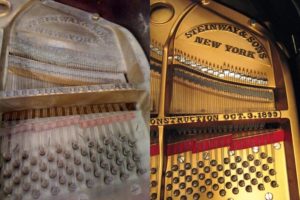Rebuilt, Restored, Refurbished…Reality: Introduction to these Piano Terms
This piano was rebuilt. That piano was restored. These pianos are refurbished. What does that mean? Unfortunately, these are not technical terms with an agreed upon definition. This is a short introduction of what to look for, what to watch out for, and a healthy reminder of how to use your own common sense. It is too complicated to become an instant expert, but there are simple strategies to save you from risky decisions.
Let’s start with “refurbished pianos.” This is the most inclusive term and therefore, the most vague. TheFreeDictionary.com defines refurbish as: To make clean, bright, or fresh again. An air compressor, a buffing wheel, and a tuning hammer may be all you need to technically refurbish a piano. Refurbishing may include some replacement of parts and often cabinet refinishing. I avoid using the term because many people wrongly imply that the work done is more extensive than an improved presentation of the piano. In truth, I like this kind of refurbishing because if the mechanical core of the piano is good, then the piano in many ways will be like new. The downside is that a nice finish and clean insides may distract the customer from evaluating the mechanical core’s true condition.
Piano rebuilding is also an imprecise term, but usually when the piano gets new strings, people start talking about rebuilding. Rebuilding as opposed to refurbishing, generally includes the replacement of at least some components. The quality of the parts used as well as the skill of the rebuilder will have a great affect on the results. Rebuilding a piano that is 30 years or older may extend the life of the piano for many years. Rebuilding a younger piano should raise questions about why. There are only a few good reasons to rebuild a relatively young piano. The range of rebuilders is like the range of home subcontractors – from very bad to absolutely top-notch. Note: most piano technicians are reluctant to disparage another technician’s work. In this case, customer references are essential. Professional references from universities or musical institutions should indicate the work is good and can withstand a high level of scrutiny.
Piano restoration is a synonym with rebuilding, but restoration implies a more complete job. Piano restoration is intended to bring the piano back to its original new condition inside and out. This means all new working parts, refinishing, a new pinblock, and soundboard repair or replacement and more. Like rebuilding, restoration has no set standard, so results and costs will vary. Full restoration is labor intensive and the best components are not cheap. Again, references are usually the best way to screen for piano restorers followed by a test drive of some of their work.
Piano restoration is a niche. A good technician may be fully capable of many kinds of repairs but still not have the right kind of experience to complete a restoration. Restoration requires a significant amount of space and tools, a time commitment that usually requires that they work as a rebuilder first and technician second. Well meaning technicians often get in over their head when they could better serve their customers by referring to a restoration facility.
Again, understanding that piano rebuilding is not cheap, use common sense. Sometimes people believe they’ve found a high-quality, rebuilt piano for cheap. “$3k U1s cannot have new strings, new hammers, new key bushings, new
damper felts, etc. This stuff costs more than the $3k to be done right
and with proper materials even in a third world sweatshop.” – Marty Flinn (Co-Author of The Complete Idiot’s Guide To Buying A Piano), from PianoWorld.com Piano Forums. And yet these mystifying claims are repeated by confused customers. When in doubt, hire a qualified, independent piano technician to evaluate the physical condition of the used piano you are considering.
Hopefully, this has served as a good introduction to de-mystify these terms commonly applied to used pianos. Learning these terms will help you ask better questions and avoid bad assumptions the next time you are considering a piano.
